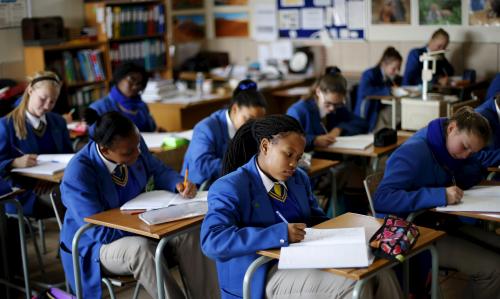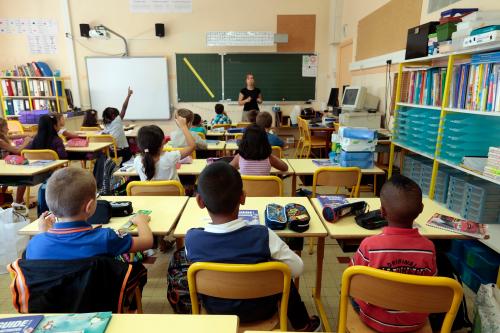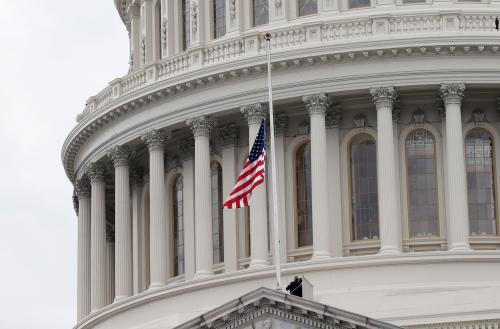Public schools in America were established to equip students with the tools to become engaged and informed citizens. How are we doing on this core mission? Last week, the National Center of Education Statistics released results from the 2018 National Assessment of Educational Progress (NAEP) civics assessment to provide an answer. The NAEP civics assessment was first given in 1998 and has been administered to students in fourth, eighth, and 12th grades every four years since 2006. (Due to budget constraints, the last two test administrations have been conducted among eighth graders only.)
Following on the heels of the underwhelming 2019 results in math and reading, the latest civics results from the Nation’s Report Card are also lackluster. The overall score dropped one point, declining from 154 points in 2014 to 153 points in 2018. Though this change is not statistically significant, it reverses a streak of modest improvement since 2006. Also, the percentage of students performing at or above the proficient level in civics remains low: Less than a quarter of students demonstrated solid academic performance and competency in civics and government based on NAEP standards.
Looking at the NAEP civics results by student subgroups (race/ethnicity and income), we do not observe significant changes in the average scores of white, Black, and Hispanic students in comparison to 2014. We plot trends in nationwide test score gaps by race and ethnicity (white-Black and white-Hispanic) and by family income (based on students’ eligibility for free or reduced-price lunch). The race/ethnicity and income gaps are shown in standard deviation units.
Both the white-Black and family income gaps have remained more or less flat over the last two decades, and the magnitude of the gap is troubling. Where an average student grows between 0.4 to 0.5 standard deviations per grade, these achievement gaps represent approximately 1.5 to two years of growth in grade-level equivalents. The trend has been more encouraging for the white-Hispanic gap, which has narrowed significantly over the last two decades, though a sizable gap persists.
These latest results are noteworthy given that 2018 was the first civics test administered after the enactment of the Every Student Succeeds Act (ESSA) in 2015, which provided greater flexibility to states in the design of their accountability systems. This change essentially removed federal law’s laser focus on math and reading that characterized the No Child Left Behind (NCLB) era, and one might have expected subjects beyond reading and math to flourish in this new learning environment. However, we see no such improvement here, and it is consistent with the general findings noted in our 2018 Brown Center Report on civics.
Along with the civics test results, the NAEP release also includes information about students’ learning experiences in civics classrooms. We plot the overall tabulations of the various activities in Figure 2 below.
As with the overall disappointing results, we see much room for improvement here too, since most students are rarely, if ever, engaging in five of seven reported activities.
One hidden gem in the NAEP data on activities, though, is that racial gaps favoring white students are non-existent in these practice responses. In fact, to the extent that any racial gaps in activities are evident, they often favor students of color. Figure 3 reports the response rates of those “often” or “always” participating in these activities by race/ethnicity among the five most commonly reported practices. Black students report these activities in the highest frequencies, and rates are slightly higher among Hispanic students as well, in comparison to reported frequencies among white students.
We are unclear why a large racial achievement gap persists based on measures of civic knowledge, but no gap (or even a reversal of that gap) among practices is documented in classroom practices. Though this could prompt a discussion of whether different types of engagement in democracy are readily substitutable, or are equally effective in creating change.
Greater youth participation can come from improved civics education
The low overall proficiency rate in civics continues to be an area of concern that warrants discussion of what schools can do to more effectively promote civic engagement. Though the causal relationship between classroom practices and democratic participation is not well defined, a growing literature examines the relationship. For example, states that require students to pass a civics exam during high school have higher levels of youth voter registration and turnout. In another study, taking a civics course and participating in extracurriculars shows a positive association with voting as a young adult.
Mathematica led a high-quality study of Democracy Prep, a charter school network based in New York with a mission to educate “citizen scholars.” Utilizing the results of the charter school admissions lottery for random assignment, the study found those who secured a space in Democracy Prep were about 16 percentage points more likely to register to vote and 12 percentage points more likely to turnout on Election Day as adults. Impact estimates of this magnitude are noteworthy in any study, but they are especially dramatic against the backdrop of youth voter participation statistics, where roughly half of young people register to vote and even fewer cast a ballot.
Contrary to the voter apathy that is often assumed, young people report an interest in politics, but they run into structural barriers that undermine their well-minded intentions. These barriers include navigating the complexities of voting and carving out time in their schedules to vote (or request an absentee ballot ahead of time). A new book by John Holbein and Sunshine Hillygus makes the argument that we can achieve a more engaged youth through several reforms, including comprehensive civics education in schools that goes beyond the facts to illuminate the various ways individuals can engage in democracy.
Democratic engagement through action
In fact, many scholars argue it is learning activities that put democratic principles into action—not simply the civics knowledge itself—that promotes greater democratic participation as young adults. Organizations like Generation Citizen and initiatives like the Purple Project (affiliated with Brookings) have emerged to stress the importance of educating citizens, particularly young people, about how they can get more involved in democracy. The lack of a strong racial or ethnic gap in the classroom activities reported on NAEP, then suggests that democratic engagement as adults could also be roughly equitable across races.
Interestingly, younger Americans are more likely to advocate for their interests through informal avenues, even if they have low rates of formal political engagement as described above. These informal routes include attending protests or utilizing social media. The Harvard Public Opinion Project’s latest poll indicated that 30% of young voters aged 18 to 29 consider themselves to be politically engaged or politically active, a notable improvement over the past two years. Other sources indicate youth activism shows an increasing trend over time, with particularly high levels of activism among Black college students.
Despite their activism, though, young people are steering clear of formal political positions, as two-thirds of youth said they will never run for elected office. In a national survey of more than 4,000 high school and college students, Lawless and Fox report that young people want to improve their communities and enact change in the world, but they do not think politics is the way to achieve these goals. The lack of interest of youth in running for office is troubling as elected officials are also aging. The average age of House and Senate members at the beginning of the 116th Congress was 58 and 63 years, respectively. (Though it’s worth noting Alexandria Ocasio-Cortez’s record as the youngest woman in history to be elected to Congress at 29 years of age). Also, the champion of the 2020 presidential election will be the oldest president in American history to give the inaugural address. This aging trend is not limited to federal office, as young people are also underrepresented in state offices as well.
The reported activities of young people and students of color provide encouraging signals about their future trajectory, though to this point much of this activity still appears limited to the informal side of democratic action. Converting this informal action into formal actions like voting, advocacy, and running for political office in greater numbers will increase the influence of young people in our democracy; in turn, this will lead to more policymakers leaning into topics that disproportionately impact young people. Gun violence in schools and climate change readily spring to mind as examples, though other topics including education and the deficit are critically important to this constituency. Improved civics education is key to making this conversion come to fruition.











Commentary
Latest NAEP results show American students continue to underperform on civics
April 27, 2020